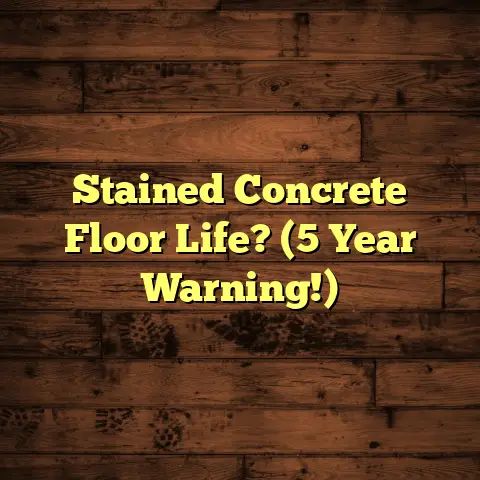Alcohol On Wood Floors: Safe? (1 Mistake To Avoid!)
As a flooring contractor, I’ve seen it all when it comes to wood floors.
And trust me, some things are scarier than others.
Today, we’re diving into a topic that might surprise you: alcohol and your precious wood floors.
Is it a match made in heaven, or a recipe for disaster?
Let’s find out!
Introduction: Weather and Its Impact on Wood Floors
Before we get into the nitty-gritty of alcohol, let’s talk weather.
You might be wondering, “What does the weather have to do with my floors?”
Well, everything!
Think of your wood floors as living, breathing things (okay, maybe not breathing, but you get the idea).
They react to their environment, especially humidity and temperature.
Humid Summers: Wood absorbs moisture, causing it to expand.
Dry Winters: Wood loses moisture, leading to contraction.
I’ve seen floors buckle and crack
simply because of extreme weather
changes.
So, understanding this
relationship is crucial.
Section 1: Understanding Wood Floors and Their Vulnerabilities
Okay, let’s talk wood. Not all wood floors are created equal.
Here’s a quick rundown:
Solid Wood: Made from a single piece of wood.
Classic, beautiful, but most vulnerable to moisture.Engineered Wood: Multiple layers of wood glued together with a top layer of hardwood.
More stable than solid wood.Laminate: Synthetic material that mimics wood.
More resistant to scratches and moisture, but not actual wood.
Wood, by its very nature, is absorbent.
It’s like a sponge, soaking up any
liquid it comes into contact with.
And when it comes to alcohol, that’s where the trouble begins.
Remember those weather conditions we talked about?
Well, extreme humidity or dryness can make your wood floors even more vulnerable to damage from spills and cleaning products.
That’s why using alcohol-based products on wood floors can be a risky game.
Section 2: The Chemistry of Alcohol and Wood
Let’s get a little science-y for a minute.
Common alcohols, like isopropyl alcohol (rubbing alcohol) and ethanol (found in some cleaners), are powerful solvents.
They’re great at dissolving grease and grime, which is why they’re used in so many household products.
But here’s the problem: alcohol can also dissolve wood finishes like polyurethane and varnish.
These finishes are your floor’s first
line of defense against moisture and
stains.
When alcohol breaks down these
protective layers, it leaves the wood
exposed and vulnerable.
I’ve seen cases where repeated use of alcohol-based cleaners has completely stripped the finish off wood floors, leaving them dull and unprotected.
Section 3: Common Uses of Alcohol on Wood Floors
Now, let’s be honest, alcohol is everywhere.
It’s in our hand sanitizers, our disinfecting wipes, and even some of our cleaning products.
So, it’s no surprise that it sometimes ends up on our wood floors.
Here are a few common scenarios:
-
Cleaning: Some people use alcohol to disinfect or clean up spills.
-
Stain Removal: Alcohol is sometimes used to try and remove stubborn stains.
-
Accidental Spills: Let’s face it, we’ve all spilled a drink or two.
The problem is, there’s a lot of misinformation out there about the safety of alcohol on wood floors.
Some people believe that a quick wipe with alcohol is harmless.
Others think that if the alcohol evaporates quickly enough, it won’t cause any damage.
But trust me, these beliefs can lead to serious problems down the road.
Section 4: The One Mistake To Avoid
Alright, here it is, the one mistake you absolutely must avoid:
Leaving Alcohol on Your Wood Floor For Too Long!
It’s that simple.
The longer alcohol sits on your wood floor, the more damage it can cause.
Even a few minutes can be enough to etch the finish or cause discoloration.
I’ve seen floors with permanent rings and spots from spilled alcohol that wasn’t cleaned up immediately.
The implications of this mistake are huge:
-
Damaged Finish: Dullness, scratches, and peeling.
-
Wood Damage: Staining, warping, and cracking.
-
Costly Repairs: Refinishing or even replacing the floor.
Let me tell you about a client of mine, Sarah, who learned this lesson the hard way.
She spilled some nail polish remover (which contains alcohol) on her wood floor and didn’t clean it up right away.
When she finally did, there was a noticeable dull spot where the remover had sat.
She tried everything to fix it, but nothing worked.
In the end, she had to hire me to refinish that section of her floor, which cost her hundreds of dollars.
Section 5: Alternatives to Alcohol for Wood Floor Care
Okay, so alcohol is a no-go.
What are some safer alternatives for cleaning and maintaining your wood floors?
Here are a few options:
-
Vinegar and Water: A diluted vinegar solution can be a great natural cleaner.
-
Soap and Water: Use a mild soap specifically designed for wood floors.
-
Commercial Wood Floor Cleaners: Look for products that are alcohol-free and pH-neutral.
When cleaning your wood floors, remember these tips:
-
Dust or vacuum regularly: To remove dirt and debris.
-
Use a damp mop: Not a soaking wet one.
-
Dry the floor immediately: To prevent water damage.
I always recommend using a microfiber mop, as it’s gentle on wood floors and effectively picks up dirt and grime.
Section 6: Real-Life Experiences and Expert Opinions
Don’t just take my word for it.
Here’s what some other experts and homeowners have to say about alcohol and wood floors:
-
“I accidentally spilled some hand sanitizer on my wood floor, and it left a sticky residue that I couldn’t get rid of,” says Emily, a homeowner from Chicago.
“As a cleaning professional, I always advise against using alcohol-based products on wood floors.
They can damage the finish and leave the wood looking dull,” says Mark, owner of a cleaning company in New York City.“I learned the hard way that alcohol and wood floors don’t mix.
I used rubbing alcohol to try and remove a stain, and it ended up making it worse.
Now I have a permanent spot on my floor,” says Jessica, a homeowner from Los Angeles.
These stories highlight the importance of being cautious when using alcohol around wood floors.
Even a small spill can have lasting consequences if not addressed properly.
Conclusion: Summarizing the Risks and Best Practices
So, let’s recap:
Weather affects wood floors, making them more susceptible to damage.
Alcohol can break down wood finishes and damage the wood itself.
The biggest mistake you can make is leaving alcohol on your wood floor for too long.
There are safer alternatives for cleaning and maintaining your wood floors.
Remember, your wood floors are an investment.
Taking care of them properly will ensure that they last for years to come.
Don’t let a simple mistake ruin their beauty and longevity.
Thanks for reading, and happy flooring!





